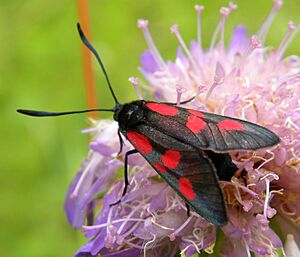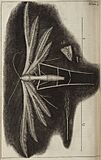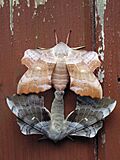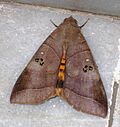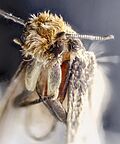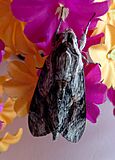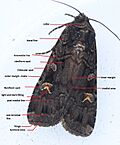Moth facts for kids
Quick facts for kids Moths |
|
|---|---|
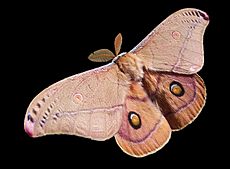 |
|
| Emperor Gum Moth, Opodiphthera eucalypti | |
| Scientific classification | |
| Kingdom: | |
| Phylum: | |
| Class: | |
| Order: | |
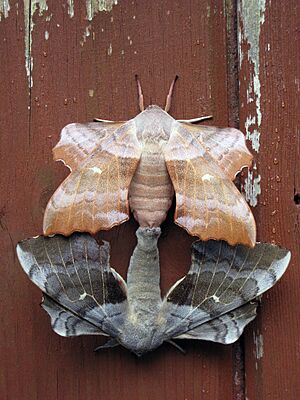
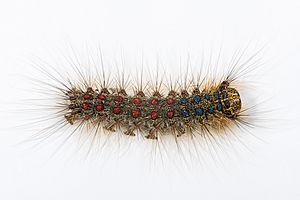
Moths are insects that belong to the group called Lepidoptera. They are very similar to butterflies, which actually developed from moths a long time ago. Most types of moths are active only at night.
You can tell moths apart from butterflies in a few ways. Moths often have antennae that look like tiny feathers. When they are not flying, moths usually hold their wings flat on their backs.
Most insects in the Lepidoptera group are moths. Scientists believe there are about 160,000 different kinds of moths. This is almost ten times more than the number of butterfly species! Many thousands of moth species are still being discovered. Most moths are very small, often called micromoths. The larger moths are more famous, but there are fewer of them. While most moths are active at night, some fly during the day or at dusk and dawn.
Contents
- Moth History: Ancient Insects
- Moths as Pests: Eating Plants and Clothes
- Silk Production: Moths That Help Us
- Attraction to Light: Why Moths Fly Towards Lamps
- Pollination: Moths Helping Flowers Grow
- Predators and Defenses: Staying Safe
- Noteworthy Moths: Famous and Unique Species
- Gallery
- Other pages
- See also
Moth History: Ancient Insects
Moths appeared on Earth long before butterflies. Scientists have found moth fossils that might be 190 million years old! Both moths and butterflies are thought to have grown and changed alongside flowering plants. This is because most modern moths, both as adults and young, eat flowering plants. One of the earliest known moth ancestors is called Archaeolepis mane. Its fossil pieces show wings with scales, similar to caddisflies.
Moths as Pests: Eating Plants and Clothes
Moths, especially their young forms called caterpillars, can be a big problem for farmers around the world. Caterpillars eat the plants that farmers grow, and sometimes they can even kill them. For example, the caterpillar of the spongy moth (Lymantria dispar) causes a lot of damage to forests in the northeastern United States. In warmer places, the diamondback moth (Plutella xylostella) is a very serious pest for cabbage crops.
Some moths in the family Tineidae have larvae that eat clothes and blankets. They prefer items made from natural materials like wool or silk. These moths are less likely to eat clothes with man-made fibers. You can try to keep them away with the smell of juniper or cedar wood, lavender, or other natural oils. Strong chemicals are often used to get rid of moths, but people worry about these chemicals being unsafe.
Silk Production: Moths That Help Us
Some moths are raised by people, which is called farming. The most important of these is the silkworm. It is farmed for the silk it uses to build its cocoon. The silk industry makes over 130 million kilograms of raw silk every year. This silk is worth about 250 million U.S. dollars!
Not all silk comes from the Bombyx mori silkworm. Several other types of Saturniidae moths are also farmed for their silk. These include the Ailanthus moth (Samia cynthia), the Chinese oak silkmoth (Antheraea pernyi), the Assam silkmoth (Antheraea assamensis), and the Japanese silk moth (Antheraea yamamai).
Attraction to Light: Why Moths Fly Towards Lamps
Moths often fly around bright lights and seem to be drawn to them. Most scientists believe this happens because moths use the light of the moon to help them fly in a straight line. The light from lamps confuses the moths, making them fly in circles around the light source.
Flowers that bloom at night usually rely on moths (or bats) to pollinate them. Artificial lights can pull moths away from these flowers. This can hurt the plant's ability to make seeds and reproduce.
Pollination: Moths Helping Flowers Grow
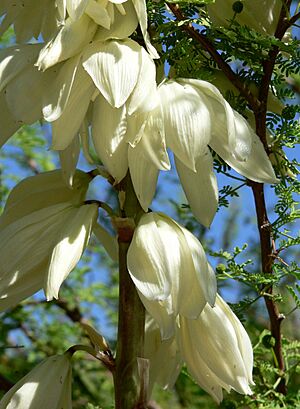
Moths usually pollinate flowers that bloom at night. This is because moths are nocturnal, meaning they rest during the day and come out at night. A moth uses its long, straw-like mouthpart called a proboscis to collect nectar, just like a butterfly does.
However, moths do not always land on the flower to get the nectar. They often hover near the flower, flapping their wings quickly while they sip. Because of this, flowers pollinated by moths do not always need a place for the moth to land. Some moth-pollinated flowers even point downward, like the yucca flowers.
Predators and Defenses: Staying Safe
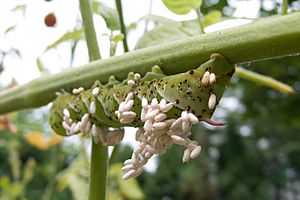
Many animals that eat insects at night feed on moths. Lots of bats, some types of owls, and other birds eat moths. Moths are also a small part of the diet for some lizards, cats, dogs, rodents, and even some bears. Moth caterpillars are eaten by many birds. They can also be attacked by ichneumon wasps, which lay their eggs inside the caterpillars.
Many adult moths and caterpillars are protected by bad-tasting chemicals they get from the plants they eat. They show off their bad taste in different ways. Some have bright colors that can be seen during the day. Some adult moths also make clicking sounds. Bats learn that these clicks are warning signals.
There is proof that the high-pitched sounds made by bats cause flying moths to move in strange ways to escape. These ultrasonic sounds make noctuid moths drop a few inches in their flight to avoid being caught. Tiger moths also make clicks that mess up the bats' echolocation, which is how bats use sound to find things.
Noteworthy Moths: Famous and Unique Species
- Atlas moth (Attacus atlas), one of the largest moths in the world.
- Hercules moth (Coscinocera hercules), the largest moth found in Australia.
- White witch moth (Thysania agrippina), the moth with the longest wingspan.
- Madagascan sunset moth (Chrysiridia rhipheus), thought to be one of the most beautiful moths.
- Death's-head hawkmoth (Acherontia species), often linked to spooky stories and seen in movies.
- Peppered moth (Biston betularia), famous for a study about how animals change over time.
- Luna moth (Actias luna).
- Grease moth (Aglossa cuprina), known to have eaten human fat.
- Emperor gum moth (Opodiphthera eucalypti).
- Polyphemus moth (Antheraea polyphemus).
- Bogong moth (Agrotis infusa), a food source for indigenous Australians in the past.
- Ornate moth (Utetheisa ornatrix), studied for how moths choose their mates.
Moth Species That Cause Economic Damage
- Spongy moth (Lymantria dispar), an invasive pest that harms hardwood trees in North America.
- Winter moth (Operophtera brumata), an invasive pest of hardwood trees, cranberries, and blueberries in North America.
- Corn earworm or cotton bollworm (Helicoverpa zea), a major farm pest.
- Indianmeal moth (Plodia interpunctella), a big pest of grain and flour.
- Codling moth (Cydia pomonella), a pest mostly of apple, pear, and walnut trees.
- Light brown apple moth (Epiphyas postvittana), a pest that eats many different plants.
- Wax moths (Galleria mellonella, Achroia grisella), pests that attack bee hives.
- Duponchelia fovealis, a new invasive pest of vegetables and ornamental plants in the United States.
Gallery
-
Diagram of a plume moth from Robert Hooke's Micrographia
-
A caterpillar of death's-head hawkmoth
-
White-lined sphinx moth in Colorado, United States
-
Adult emperor moth (Gonimbrasia belina)
-
A moth on a marble floor in Kolkata, India
-
A moth on artificial flowers in Kolkata, India
-
An adult male pine processionary moth (Thaumetopoea pityocampa). This species is a serious forest pest when in its larval state. Notice the bristle springing from the underside of the hindwing (frenulum) and running forward to be held in a small catch of the forewing, whose function is to link the wings together.
Other pages
See also
 In Spanish: Heterocera para niños
In Spanish: Heterocera para niños


